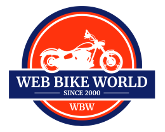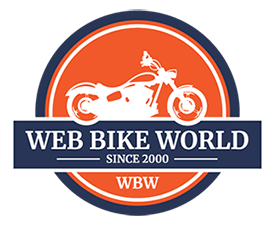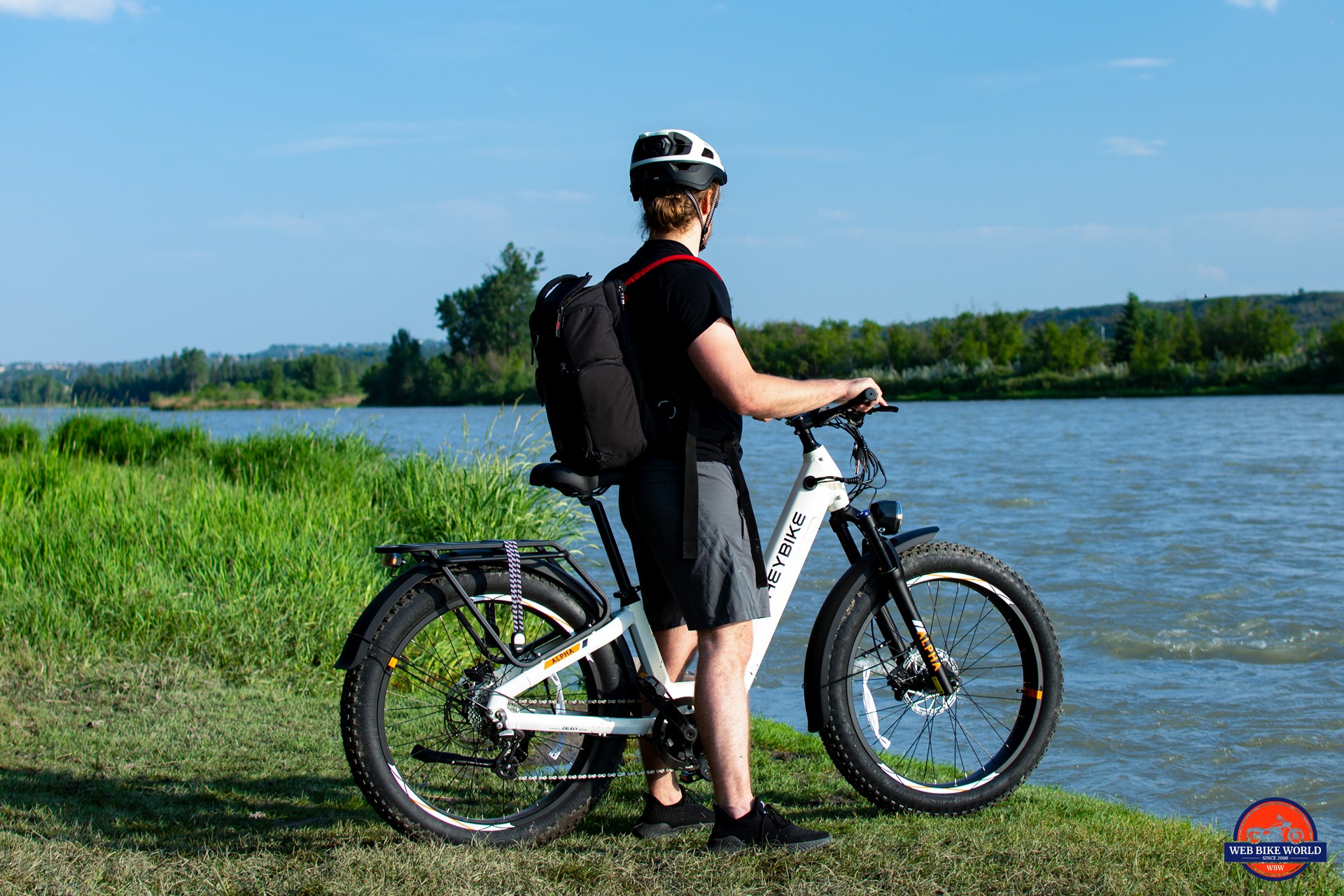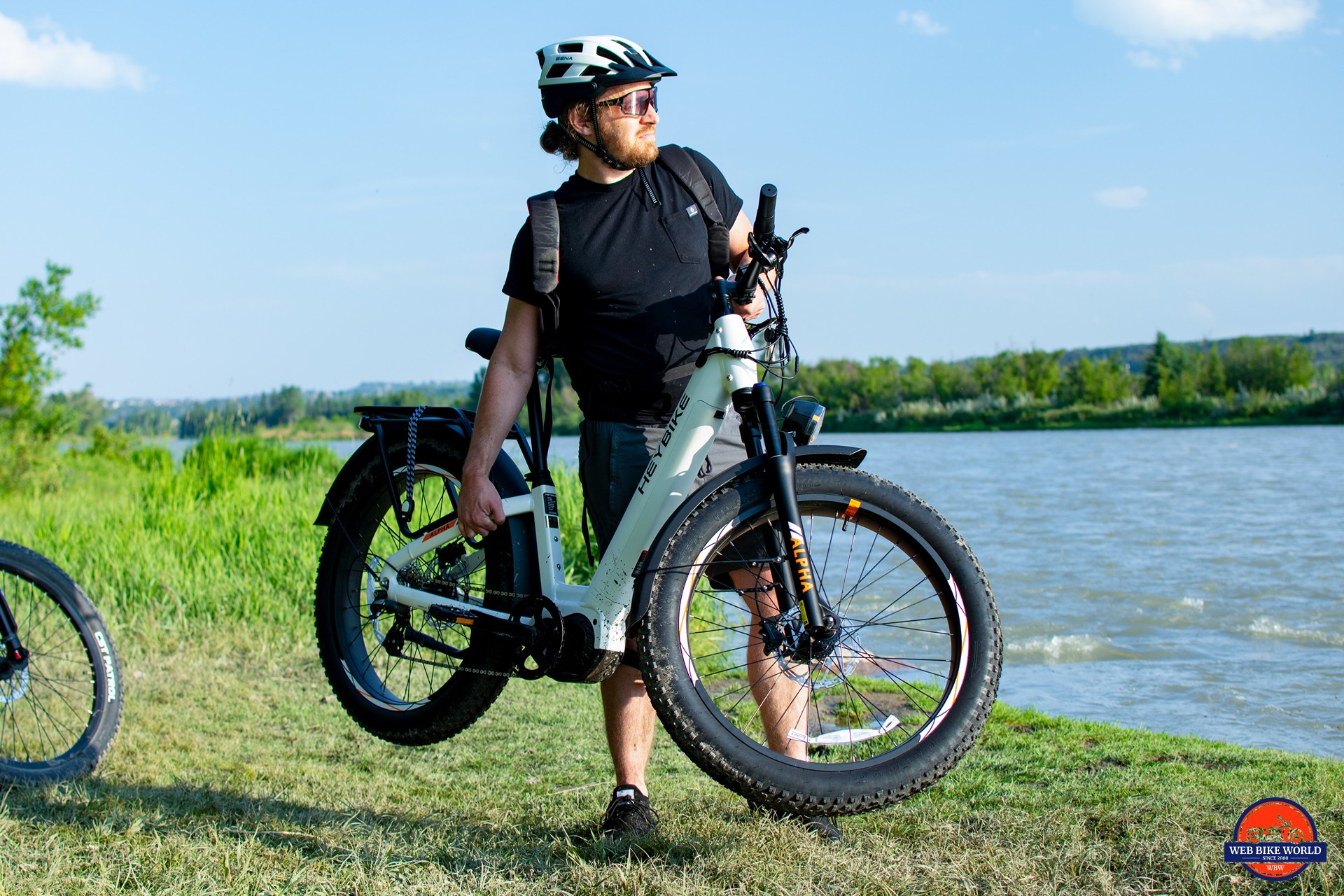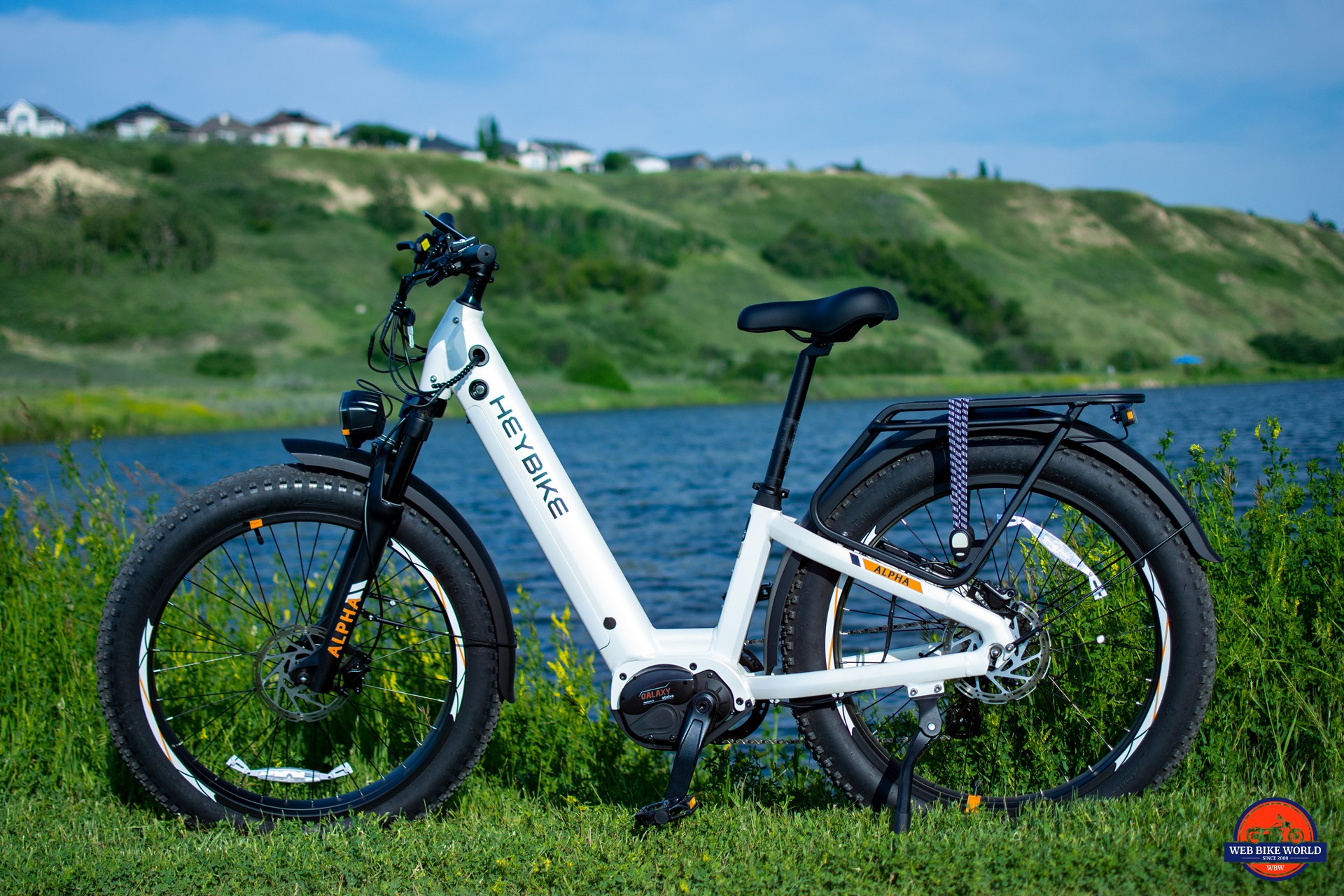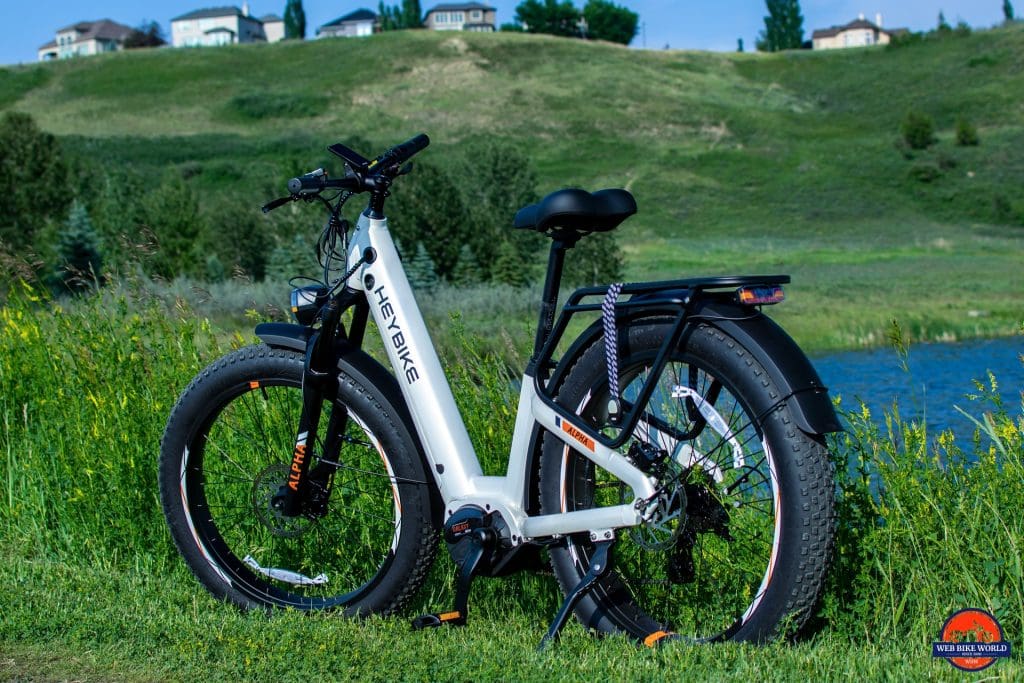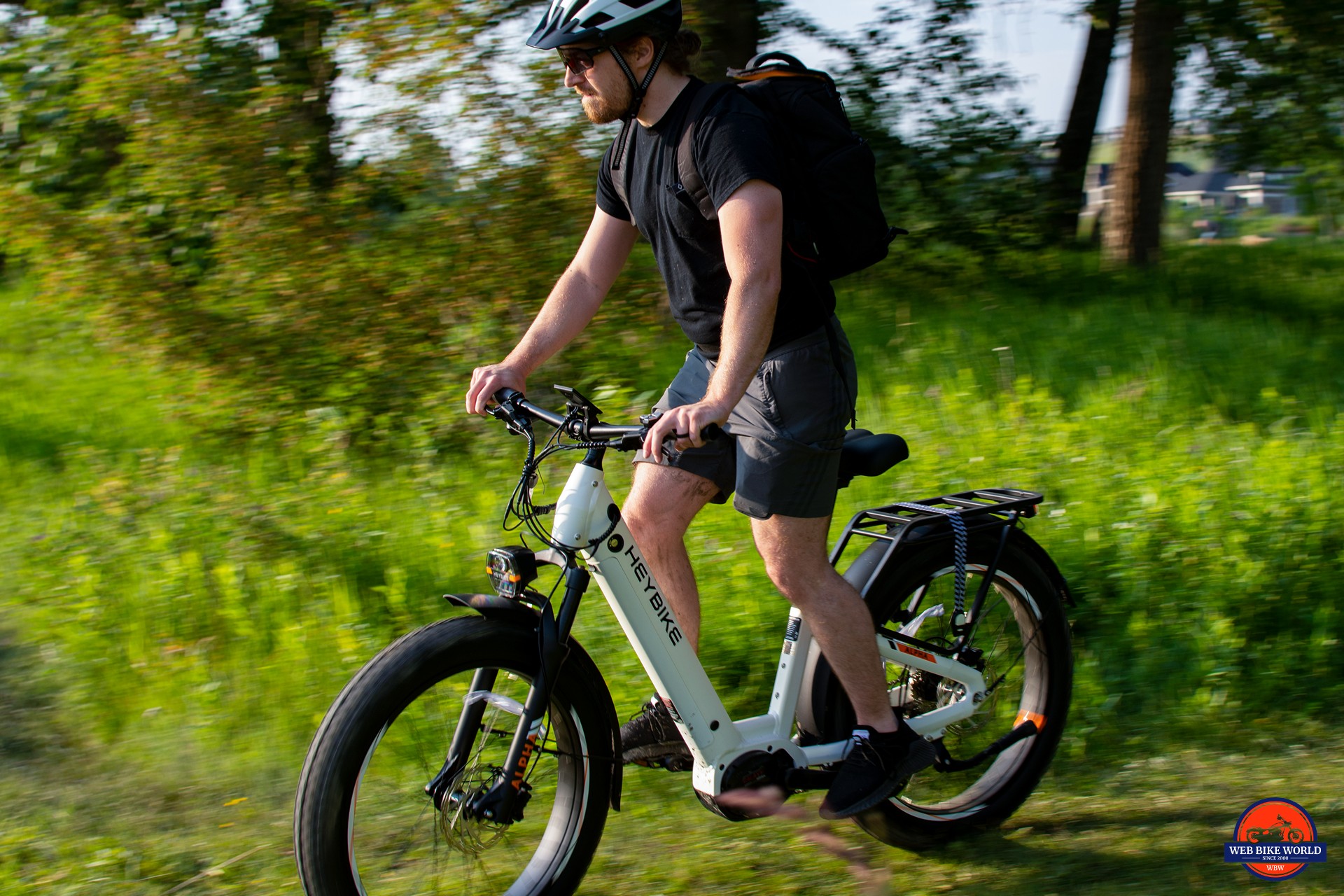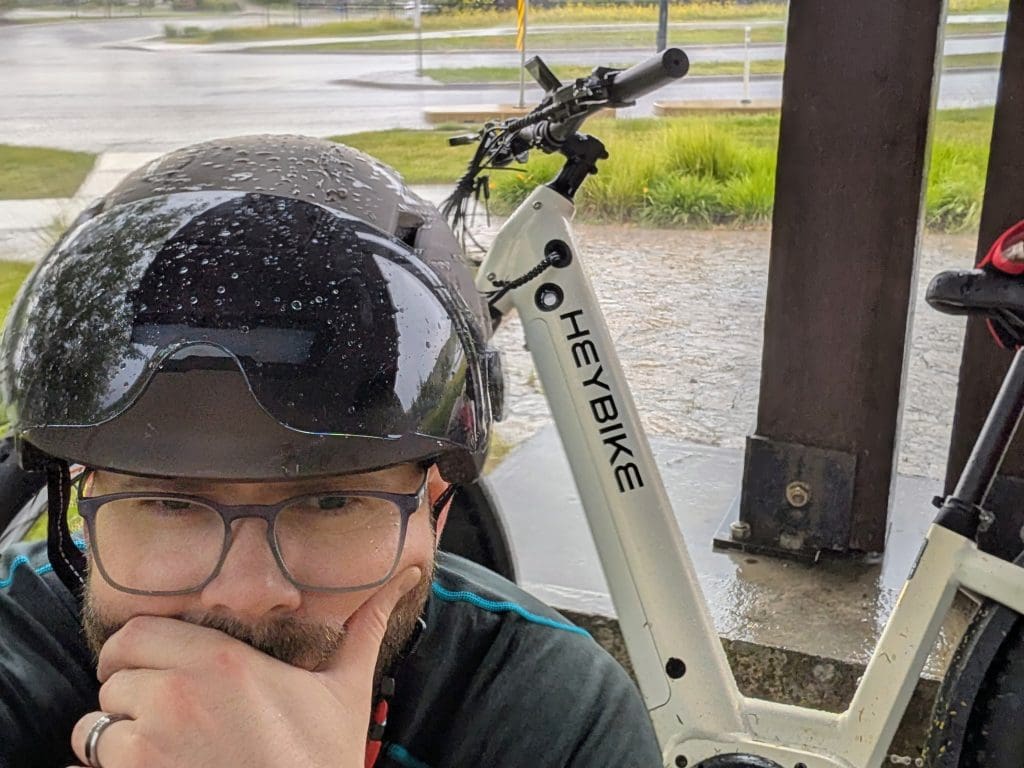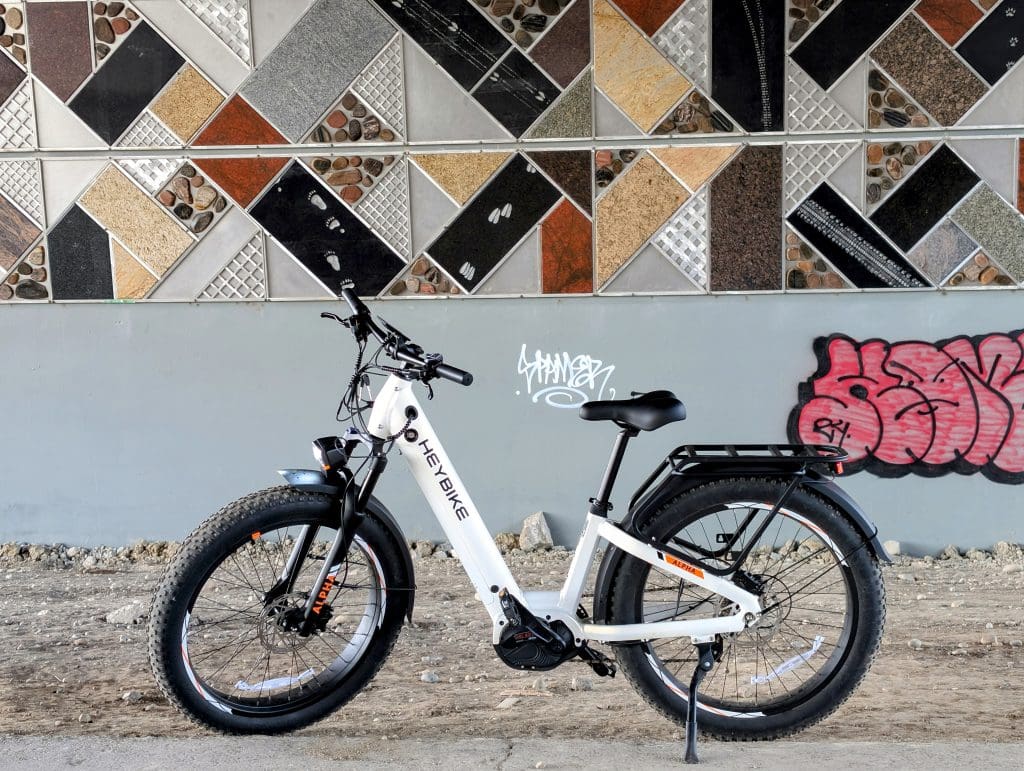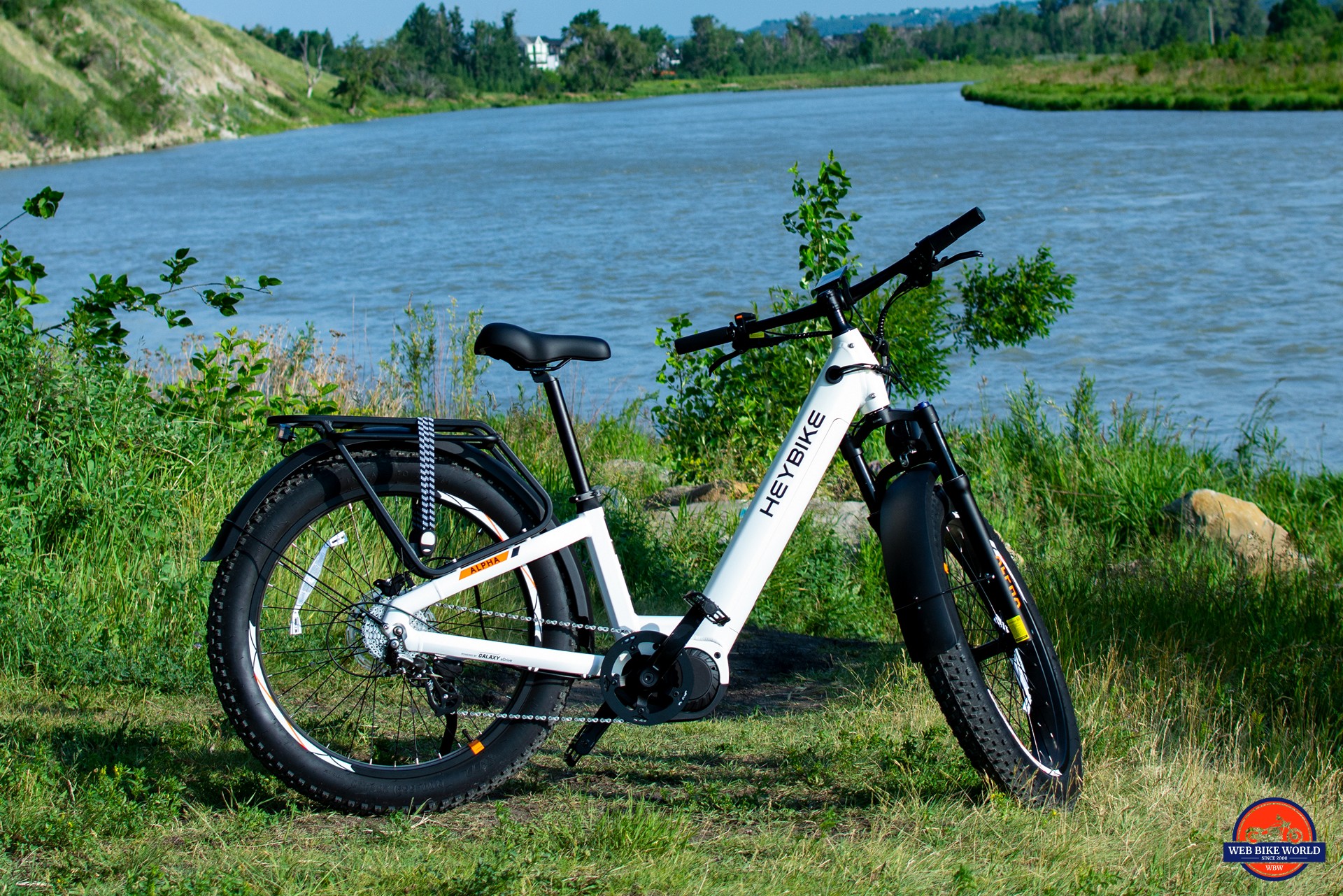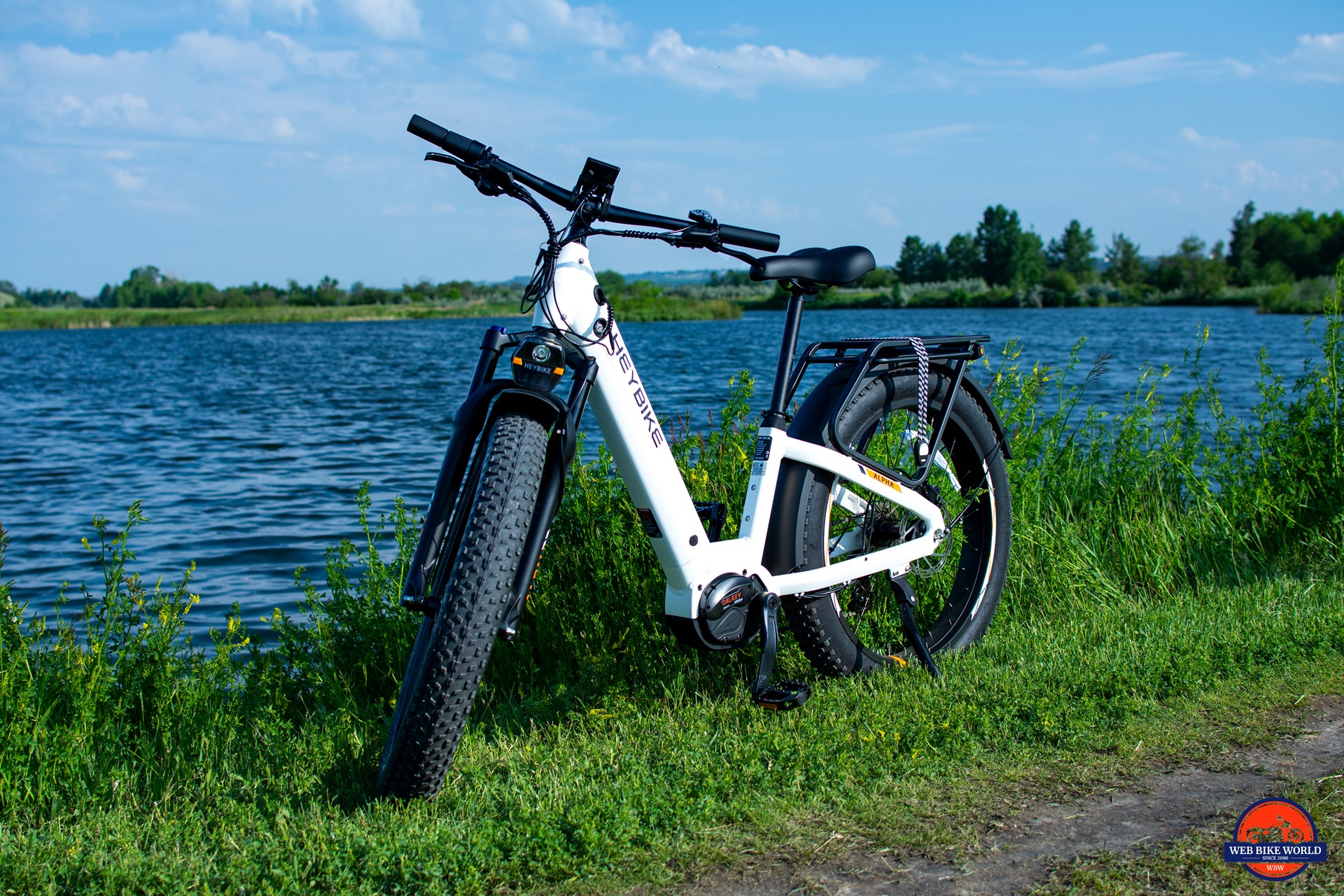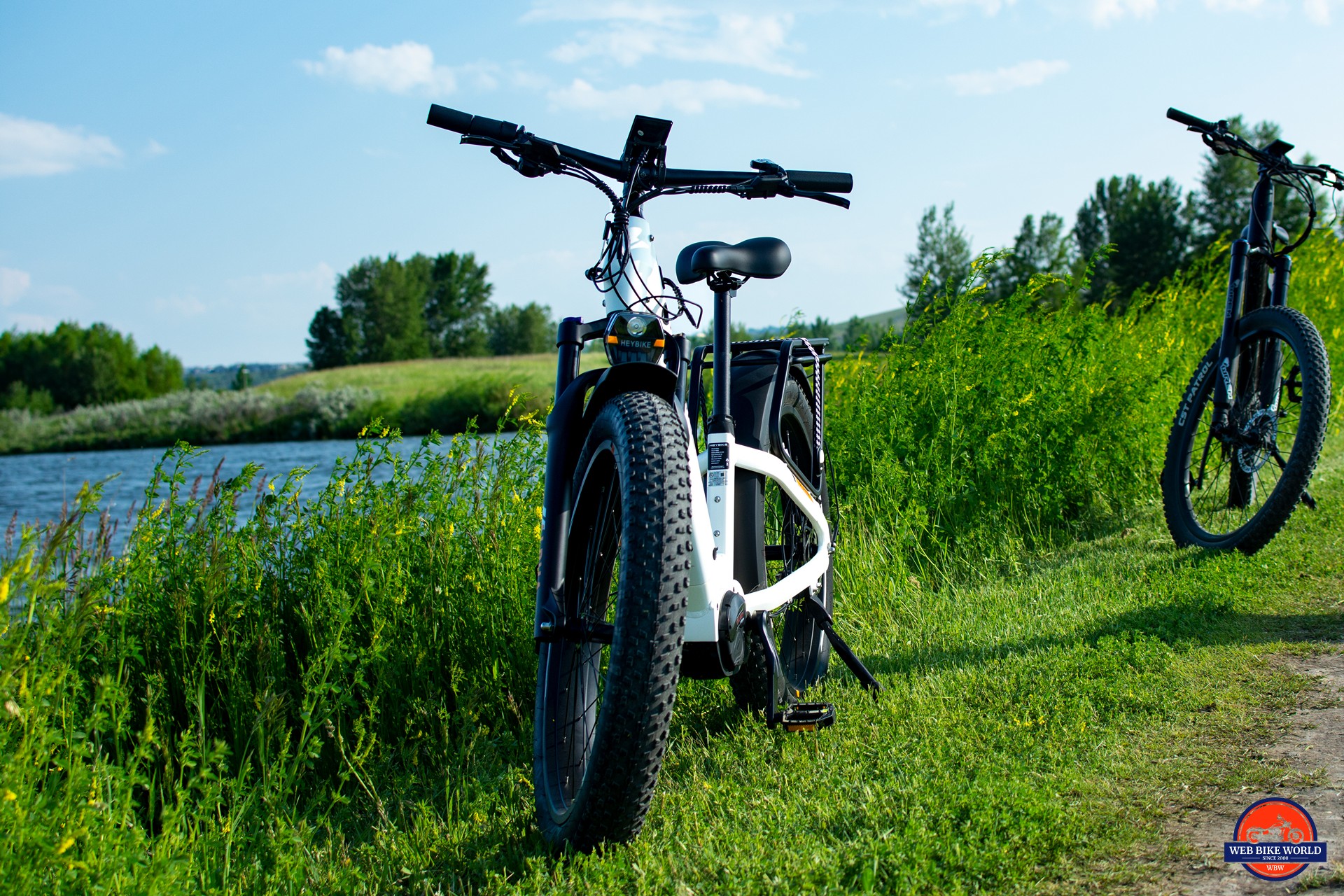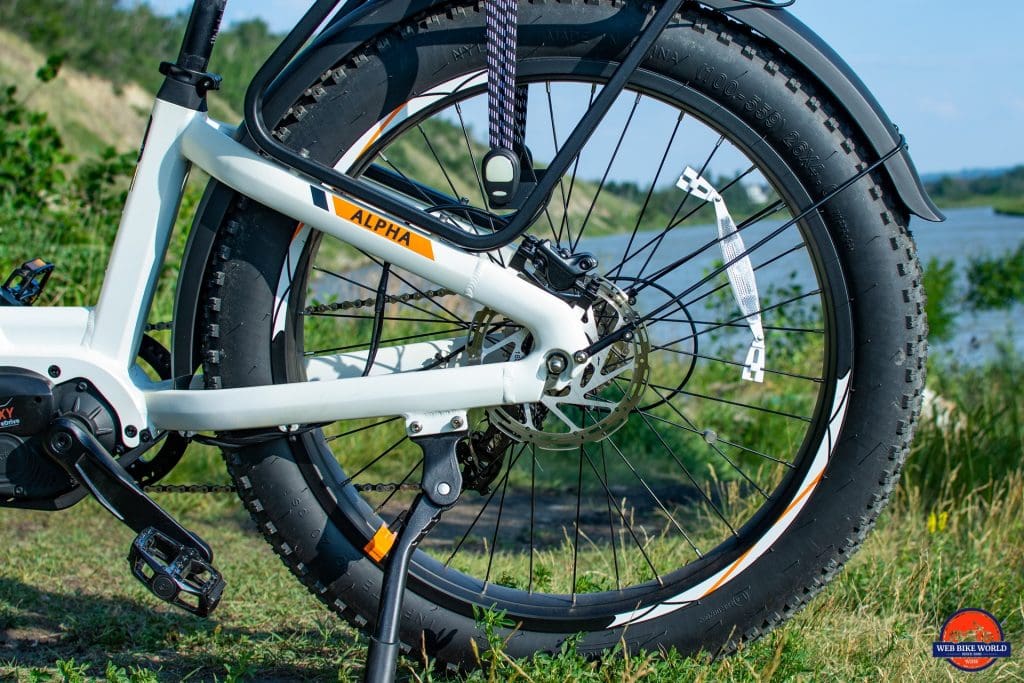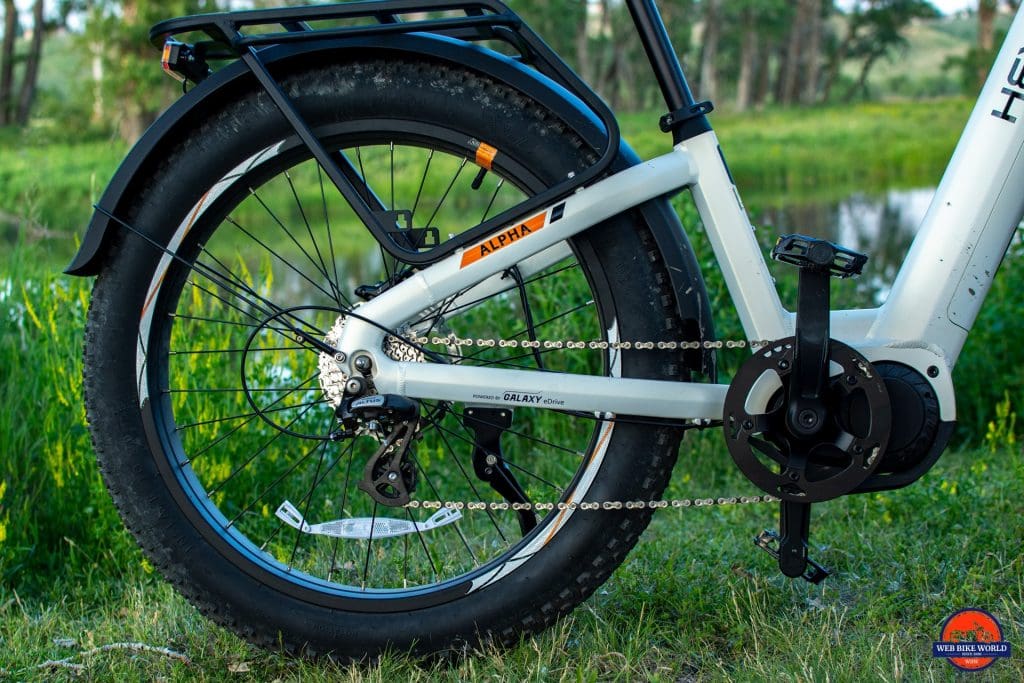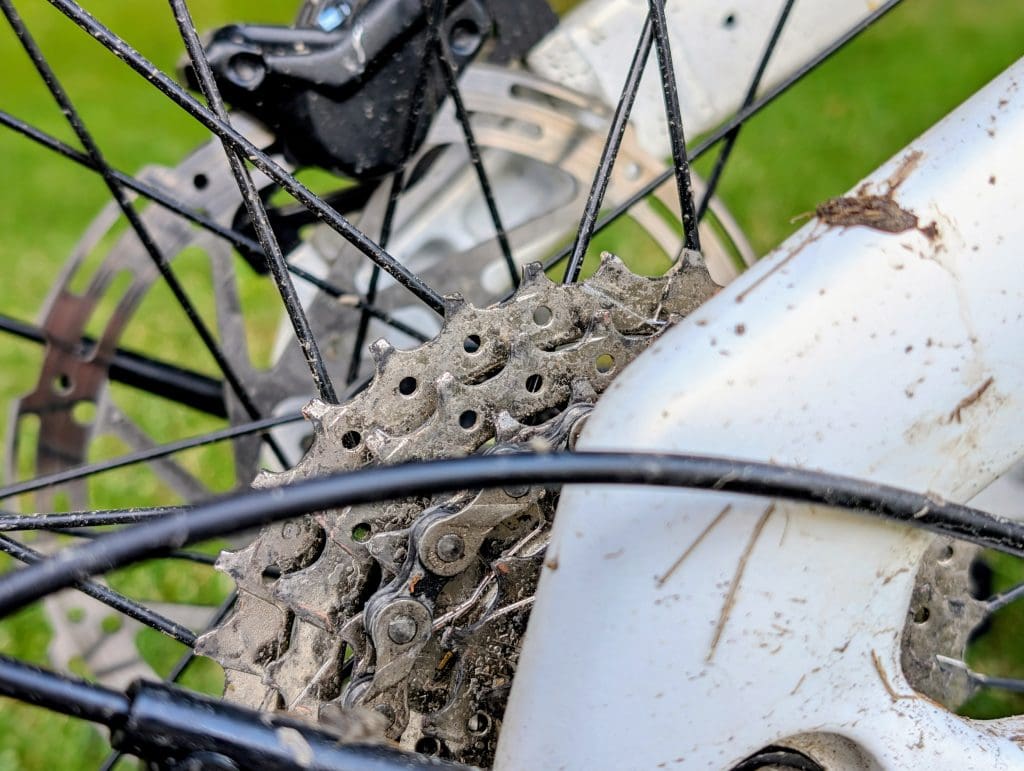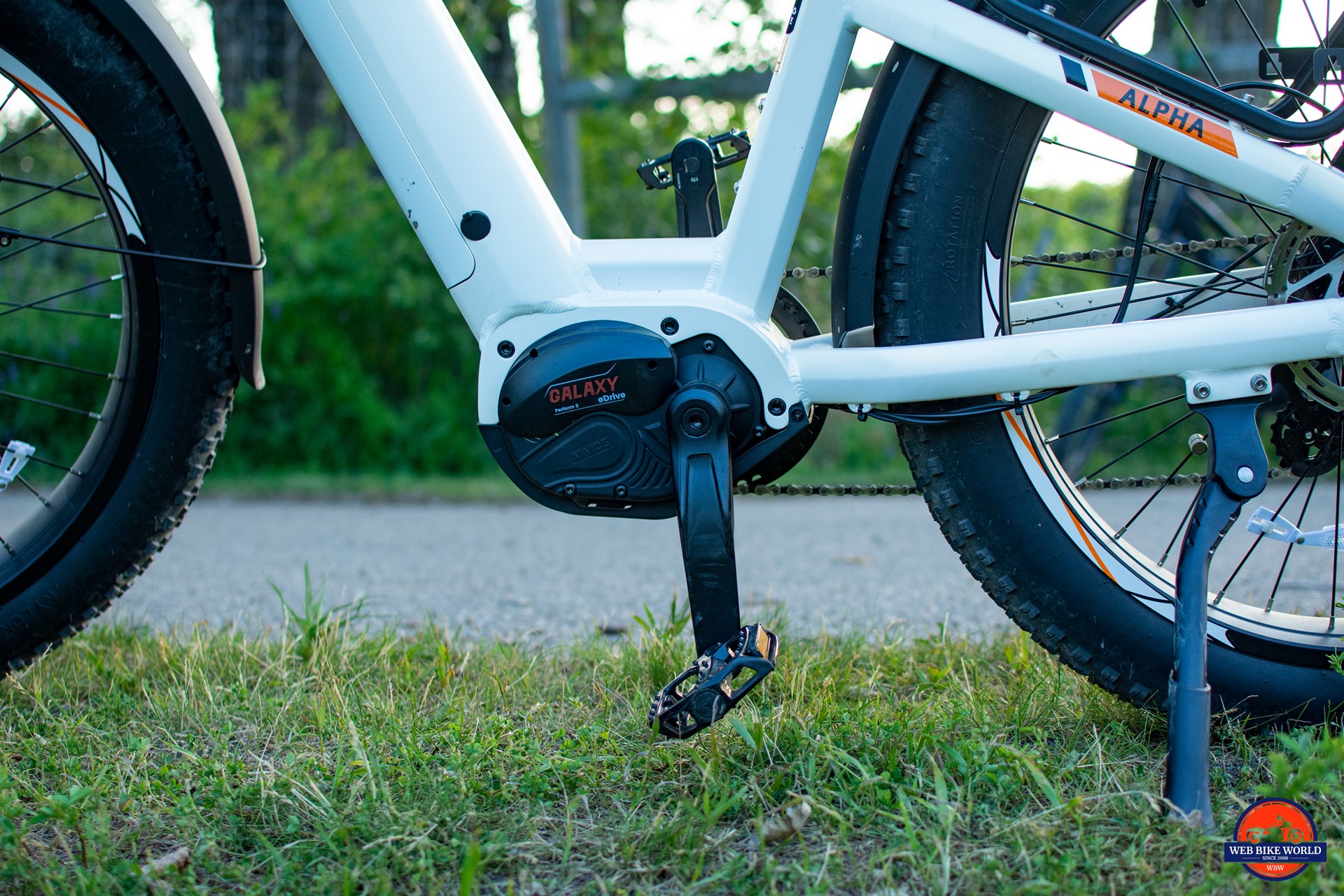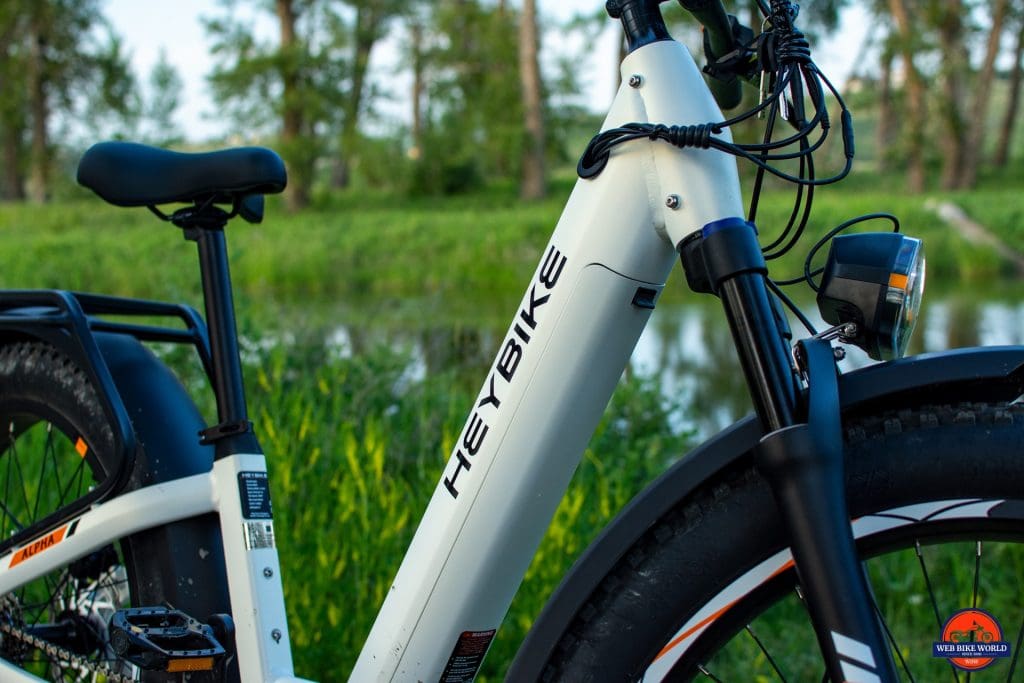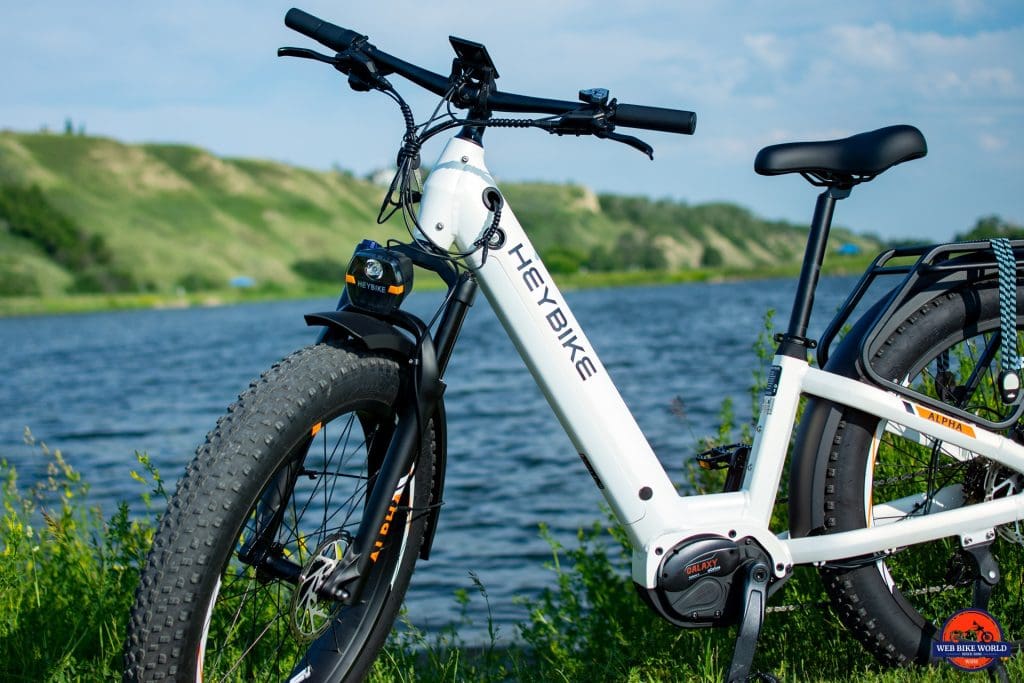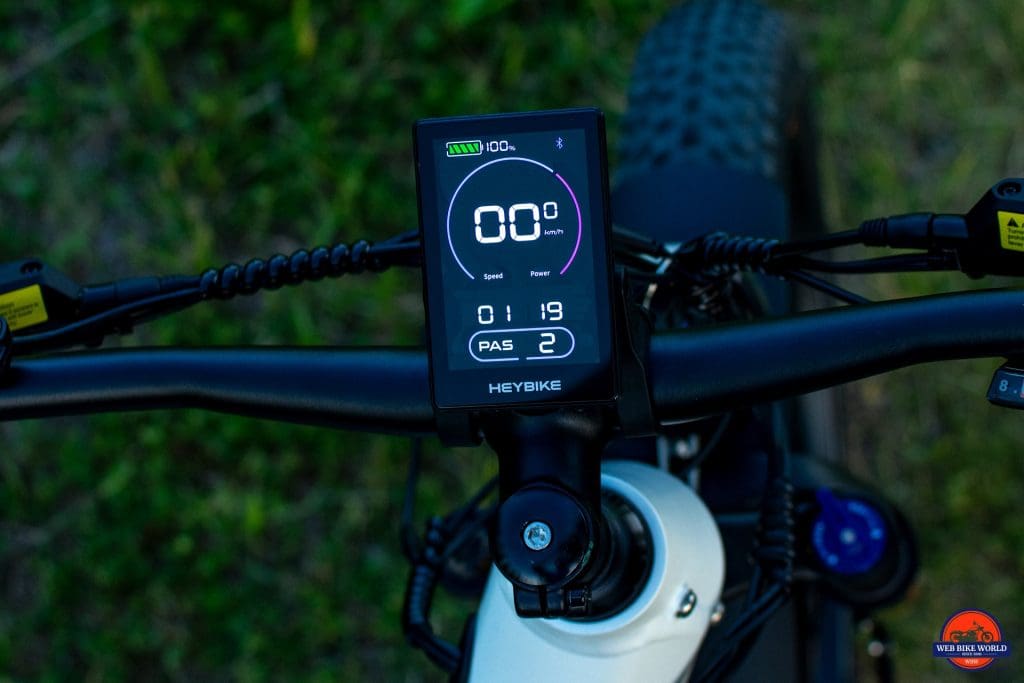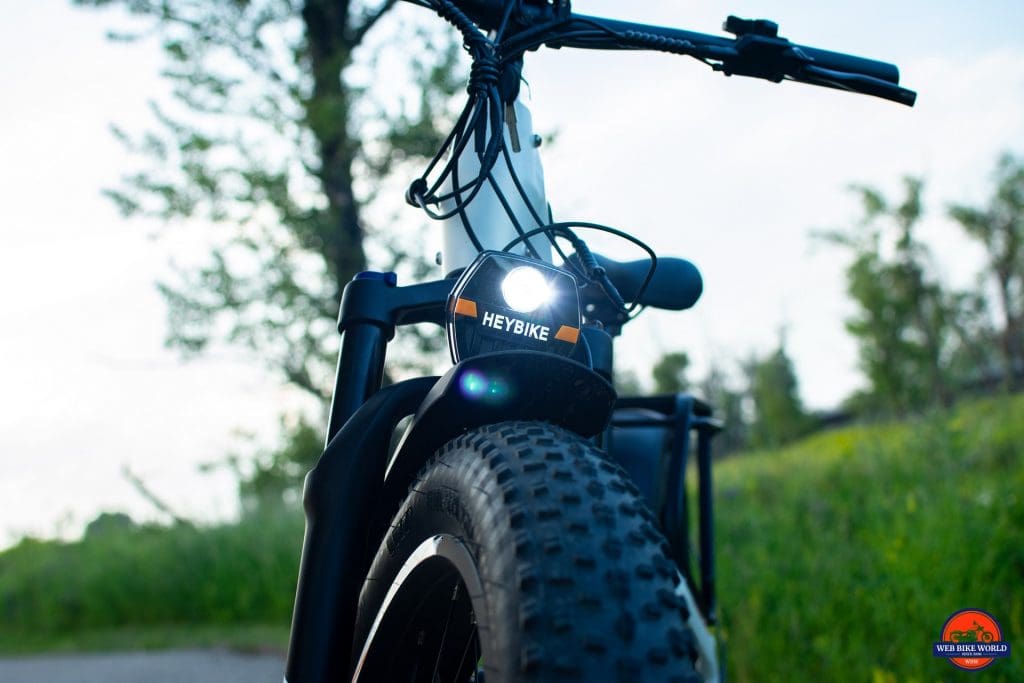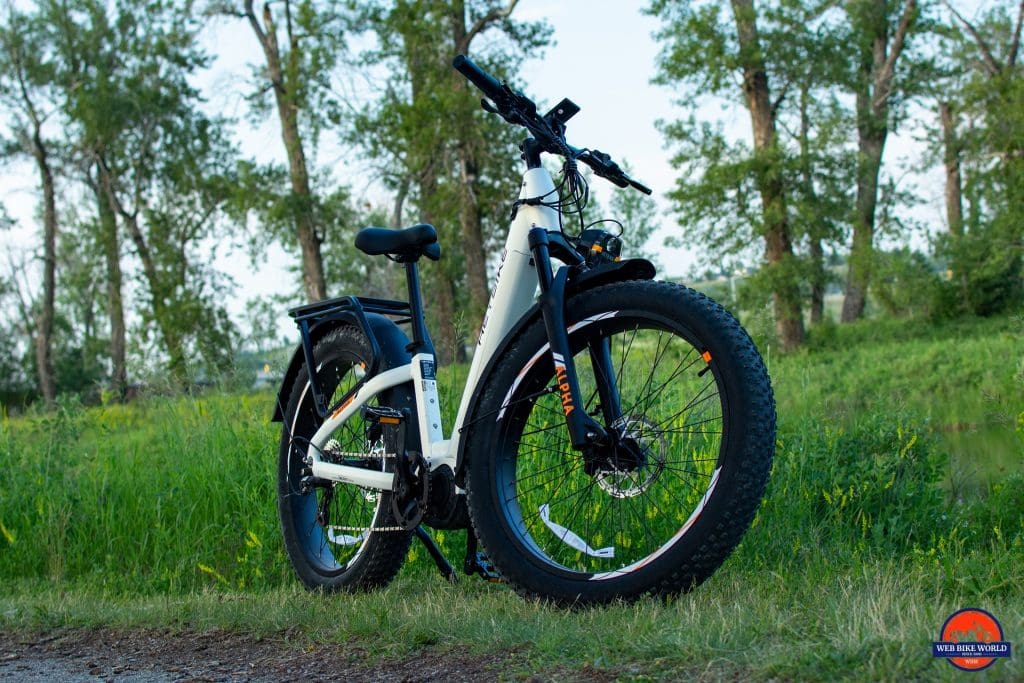I’ve reviewed several Heybikes at this point, and I’ve largely found them to be good, but not great, bikes that focus on value for money. For that reason, they typically use unbranded OEM components with hub motors (although they use brand-name cells in their batteries). With the Alpha, Heybike has entered the mid-drive market while continuing to apply its value-for-money formula.
The 2025 Heybike Alpha is a class 3 ebike and comes well equipped with front and rear fenders, a rear rack, a “bell” (erm, buzzer), front and rear powered lights, and even a cargo accessory strap.
Those are nice-to-haves, of course, but it’s the mid-drive motor at this very accessible $1,500 USD / $2,700 CAD price point that makes the Alpha stand out.
If you’re shopping the Alpha right now, here is what you need to know before buying it:
- The groupset and cassette are not well suited for hills, so you will be relying on the motor a lot – This isn’t necessarily a downside, but if you’re someone who wants to get as much pedal power in as possible, you’ll feel the Alpha’s shortcomings without pedal assist. This will also impact the range that the small 13.5 Ah battery can provide.
- The throttle implementation is awful – I don’t know what compelled Heybike to implement what is objectively the worst throttle on an ebike I’ve ever used. It does not apply full motor power and is speed-limited to 10-13 mph /15 – 20 kph. It is not responsive, and you can’t use it from a stop or at low crawling speeds. It is, at best, a slow cruise control.
- The motor is incredibly powerful – And I’ve ridden more than one bike with the Bafang M620 (Himiway Cobra Pro, for example), which produces 160 Nm of torque. The Alpha features Heybike’s “Galaxy e-Drive system”, which is essentially a customized Mivice X700, producing a take-your-butt-anywhere 105 Nm of torque.
- App customization is limited, but still accessible – Previous Heybike’s I’ve reviewed, like the Brawn, were extensively customizable via the Heybike app. You could change speed settings per pedal-assist (PAS) level, for example. The Alpha is much less customizable: you can change units of measure, PAS level settings (0-5, 1-5, etc.), but not much else.
- Ride quality is just okay, and the suspension fork isn’t very good – The fork’s suspension is either on or off, with some preload adjustment but not much, and no other adjustability. You get a pogo-stick-like bounce as you pedal, and it doesn’t manage fast technical riding very well. I’d have preferred if Heybike went full-on fat bike and shipped it with a lighter fixed fork.
- The Alpha is sized for riders between 5’4” and 6’ – I’m 6’2” and find the bike is just a hair small, whereas Brayden at 5’9” finds the Alpha perfectly sized.
In short, there is always this sense with the Alpha that its mid-drive wants to do a lot more than what the rest of the bike can handle. It wants to fly, and it absolutely has the power to do it, effortlessly climbing hills in ways that lesser motors have no hope of matching.
That’s why it’s so frustrating that Heybike impaired the Alpha by giving it anemic suspension and a useless throttle. This bike could have been the affordable, throttled-up monster truck mid-drive that everybody on the ebike subreddits says they want, but instead, it’s a potent engine forced to run with its shoelaces tied.
I’m so disappointed, because the Alpha is literally inches away from being great; All Heybike needs to do is fix the throttle.
Words & Photography: Cameron Martel
Heybike provided a 2025 Alpha at no charge for this review. webBikeWorld does not have a financial relationship with Heybike. I have reviewed over 30 e-bikes and am an avid trail and downhill cyclist. My “acoustic” trail bike is a 2024 Orbea Occam H30, and my ebike stable is a revolving door (I currently have 7 in my garage).
With thanks to Brayden at Chaos Inc. for posing in some of my photos (including the cover) and providing his perspective on the Alpha. For reference, Brayden is 5’9”.
2025 Heybike Alpha Mid-Drive Specifications
- MSRP: $1,499 USD / $2,700 CAD
- Where to Buy: Heybike USA / Heybike Canada
- Warranty: 2 years
- Top speed: 28 mph / 45 kph PAS, 10 mph / 16 kph throttle
- eBike Class: Class 3
- Range: Claimed 60 miles / 95 km (wBW estimated 40 miles / 64 km)
- Bike Weight: 78.5 bs / 35.6 kg (including battery), weighed on our scale
- Weight capacity: 400 lbs / 181 kg (bike and rider combined)
- Motor: Mivice X700 500-watt mid-drive
- Torque: 105 Nm
- PAS: Torque sensing, 5 PAS levels
- Brakes: Generic hydraulic brakes with 180 mm calipers
- Groupset: Shimano Altus 8-speed
- Battery: 48V 13.5 Ah (648 Wh), UL certified, approximately 3.5 hours for a full charge with included 2A charger
- Wheels & Tires: 26” x 4” wheels with generic OEM tires
- Other: Headlight, powered taillight, turn signal, electric horn, adjustable stem, front and rear fenders, front/rear racks, suspension fork
2025 Heybike Alpha Aesthetics & Design
The Alpha comes in two colorways: Galaxy Black (stepover) and Pearl White (step-thru). Unfortunately, each frame is only available in its respective single color. I opted for the step-thru because I have friends and family members who appreciate accessibility, and low-step-thru frames like the Alpha are the easiest to mount and dismount.
As my brawny friend Brayden said after he was done hefting the Alpha about, “It’s honestly a great-looking bike… how much did you say this was again?”
He’s not wrong. I think Heybike has got the proportions right.
The Himiway D5 Pro – a direct competitor to the Alpha – has a similar setup, but is bulkier and less athletic-looking. The Alpha looks like it’s in shape, whereas other ODM mid-drive step-thrus tend to look like they are bodybuilding.
It’s hard to make a step-thru look good, but I think Heybike has done a good job of it.
The fat-but-not-too-fat 4” tires and fender combination round out the aesthetic. They aren’t anything special, but they are sized right and add some visual heft to the step-thru frame.
The paint job is on point. I don’t see any paint bubbles, overspray, or drip marks. The graphics on the frame, fork, and wheel are also applied nicely. Quality impressions on the frame are good, with clean welds, tidy wiring, and good proportions.
What’s the Heybike Alpha Like to Ride?
The Alpha’s riding dynamics surprised me; they are a confusing juxtaposition of capability vs. component limitations. The Alpha’s motor wants you to thrash it about, but the groupset and limp throttle beg you to slow down.
The Riverstone Test Loop
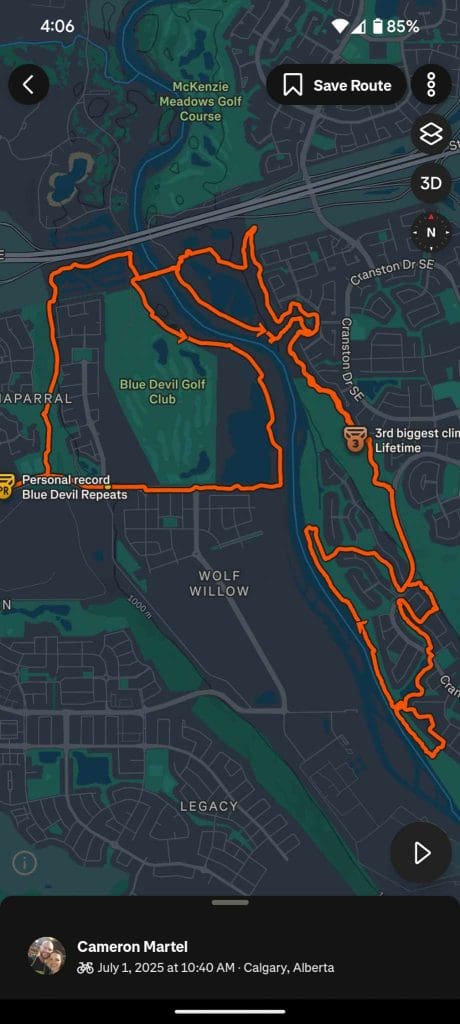
The Riverstone Test Loop is a nice mix of paved trails, dirt singletracks, grassland, climbs, technical descents, and a short but aggressive downhill section.
According to Strava, there’s a total of 850 feet / 260 meters of elevation gain.
While not as objective as instrumented tests (a shout-out to Electric Bike Report for their commitment to instrumented testing), I gain a great perspective on how different bikes and components perform in mixed terrain, allowing for a reasonable apples-to-apples comparison.
The Alpha received most of its rides during dry, temperate days in the 70-80°F range, although I did get stuck in a thunderstorm with the Alpha once (it was a wet and muddy ride home!).
The Alpha’s Strengths
- While it’s officially rated for 105 Nm of torque, I bet you it makes more than that.
- With the suspension locked out, pavement and groomed trails are relatively comfortable; I ran around 12 psi and had lots of traction.
- With the preload adjusted as soft as possible, the fat tires and suspension fork do a passable job smoothing out singletracks and flow trails.
- The frame is surprisingly sturdy considering it is a low-step-thru design. There is some flex when you forcibly wobble it about, like when you’re hitting technical trails at 10 or 15 mph, but what can you reasonably expect from a low-step frame?
- The Alpha climbs real hills with relative ease despite the weak cassette and groupset; More than once, Brayden ate my dust as the Alpha climbed prairie-grass laden hills, stomping over the twigs, foliage, and bumps with ease. Very impressive.
Where it Could Improve
- The pedals (basic flats) have no grip to them, so it’s easy for your feet to slide around when pedaling.
- The suspension fork woefully underperforms relative to the rest of the bike and often pogo-sticks when put under pressure (the suspension bounces as opposed to cushions, reducing control and making the riding experience unpredictable). It’s the obvious weakest link in the configuration, followed by the cassette.
- Rework the throttle implementation so that it behaves as expected; limiting the throttle to 12 mph and no more than 50% of engine power output severely limits its utility and value.
- Introduce a shift sensor that cuts motor power during shifts, as the groupset will slip if you are applying anything other than moderate power while shifting.
More Detail
A torque-sensing mid-drive fat tire ebike should be a dream on singletracks or when overlanding. With a properly configured torque sensor, the sensitive inputs from the motor, paired with 4” wide tires, make navigating rocks, roots, sand, snow, and other rugged terrain much easier.
That’s exactly how I felt when I reviewed the 2023 Surface 604 Boar Hunter, a fat-tire torque-sensing hub motor ebike that is one of my “benchmark bikes” because of how well it handles the terrain, including navigating the riverbank.
In the right circumstances, the Alpha is a joy to ride: the pedal assist (PAS) is smooth, responsive, and intuitive. It feels like a natural extension of my leg, and when you crank the pedal assist up, there’s a lot of power on hand that’s always accessible.
Most importantly, the Galaxy e-Drive motor and torque sensor configuration feels right; The power is predictable, easy to manipulate, and also easy to articulate. It’s great for riding in crowded, narrow, or complex areas, where extra control is essential.
I crawled along river bends, up steep grades, and over prairie grassland; the Alpha’s engine always felt light and controllable. When you’re trawling through mud or a rocky beach, you want a motor that won’t surprise you. Inputs matter.
Give it the beans and the Alpha will happily hit 28 mph / 45 kph whenever you want it to. It has so much power available that it almost taunts you with it. After all, PAS 1 is a gentle nudge, sure, but maybe PAS 5 is the kick in the pants you’re after.
The photo betrays the size and length of the hill, which is both steeper and longer than it appears (at least, that’s what my almost-39-year-old brain keeps telling itself).
This hill is approximately 4 km into my 23.5 km test loop and is the first significant hill that the Alpha will encounter. I tackle the hill head-on to see if a reasonable amount of pedal power, paired with the motor, will get me up.
To date, only a handful of ebikes have been able to get to the top of this hill without absolutely heroic effort on my behalf, two of which sported the monstrous Bafang M620 1,000-watt mid-drive and the groupset needed to put all 160 Nm of torque from that motor to use.
So naturally, I felt confident when I told Brayden that there was zero chance that the Alpha, with a “mere” 105 Nm of torque, was climbing that hill. Actually, I think the specific verbiage I used was “this wimpy cassette isn’t getting this bike up that hill, no matter how much power the mid-drive puts down”).
So, anyway, here is a video of me climbing (and then descending) the hill:
I’m not ashamed to admit that I was wrong.
Despite a bit of wiggle-action (thanks, janky pogo-stick suspension), it was relatively easy to make the climb. If the Alpha had a proper cassette, it probably would have gained speed going up; As configured, there was only so much I could contribute given its gearing, forcing the motor to pick up my slack.
Equally as surprising was how the Alpha behaved coming down, considering the Alpha’s portly 78 lb weight; No drama, no wobble, no stress – a nice, easy, controllable descent.
The fat tires were aired to 12 psi for this ride, and they took the bumpy decline in stride. The brakes also felt good, though I don’t think they would be able to bring the Alpha to a dead stop on this hill (for comparison, the Tektro hydraulic setup on the Himiway D5 Pro does bring that bike to a stop on this hill).
This initial strong performance gave me the confidence to push the Alpha for the other off-road sections in the loop, including sending it down into the river valley and climbing right back up again via singletrack trails. The more I got to know the bike, and specifically the awful suspension fork, the more fun I had riding it aggressively.
Despite using value-focused components, Heybike has created a broadly competent “monster truck” ebike that will climb, crawl, and careen down, into, and out of areas that my puny pedal power would have no hope of going on its own.
And, because of its small 13.5 Ah battery and mid-drive geometry, the Alpha feels balanced. When I stood to give myself extra oomph, the rear wheel kept its traction and let me climb hills that my hub-drive Surface 604 Shred or Himiway D5 (non-pro) would have forced me to walk up.
Unfortunately, all of this climbing capability is mired by sub-optimal downhill performance. I don’t mean hardcore mountainbike-style downhill, either.
My gripe with the suspension fork is that it’s more of a spring than it is a cushion. Where the motor is capable of taking you up most hills almost effortlessly, the suspension is incapable of getting you back down the hill without a fair bit of effort and concentration on the rider’s behalf. It reminds me of the Fucare Gemini X, which also features a very springy “on or off” suspension fork. In both cases, I’d rather the bike have a fixed fork, which would at least weigh less.
This dynamic means that the Alpha can’t hit some of the flow trails and technical singletracks as fast as most of the off-road capable ebikes I’ve tested – but it can still hit them. Sure, you’re going a bit slower, but you’re still able to be there.
The Riverstone Test Loop ends with a 1 mile / 1.6 km paved climb, and as you expect, the Alpha has no qualms with it. On pavement or groomed trails, where bumps are small and far between, the Alpha is compliant. PAS 1 will get you to 15 mph / 20 kph easily, and allow you to put in the work if you want to go faster than that.
One final note: I have not found a single instance where the throttle, as configured, is actually useful. It does not work until you are moving at about 5 mph / 8 kph, and even then, it only provides up to 50% power. In the 8th gear on flat ground, you can use the throttle to cruise at about 13 mph / 20 kph. It doesn’t provide enough power to climb hills of any length.
It’s just a confusing, awful implementation, especially considering the limitations it places on the Alpha in the name of component preservation (but again, there’s no shift cut-out, so how concerned is Heybike really?).
Unfortunately, because of this implementation, you can’t use the throttle as a rider aid. I love using the throttle to inch along the riverbank, for example, or to help get me up a particularly technical climb. Neither of these use cases is possible with the Alpha, which does have enough power to get you up a hill on throttle alone… if the throttle would let it.
Having now completed a half dozen circuits around the loop, I am both impressed by its capability and disappointed at how the suspension fork and throttle implementation let it down. While neither is a deal-breaker, it’s easy to see how a couple of minor changes could significantly improve the riding experience.
2025 Heybike Alpha Build Quality & Components
Dig below the “core” components, and you can see where the $1,500 MSRP comes from. The no-name hydraulic brakes, hubs, bearings, suspension, etc. are all low-tier entry-level.
But to hit $1,500 in 2025, post-tariffs and all, I am not at all surprised. I also can’t fault some of these decisions. The only component that I am let down by is the fork, which, in all fairness, can be changed (albeit not easily).
Brakes
I weighed the Alpha at 78.5 lbs, which is approximately 7 lbs more than the claimed weight on the Heybike website. That’s a lot of weight to move around, and accordingly, you need the right brakes.
The Alpha is equipped with no-name hydraulic brakes (with motor cutoff when engaged) and 180 mm rotors. I don’t love generic parts when it comes to brakes and tires, as these are the two components that interact with the ground and manage your speed.
That said, the brakes have performed as expected so far. Performance is average at best, but very acceptable for the Alpha’s use case and price. Don’t take this bike on hardcore trails or downhill, though; These brakes won’t live up to that type of stress.
Motor, Drivetrain, & Groupset
The 8-speed Shimano Altus groupset does the job, though I suspect that the cassette isn’t quite able to match what the motor is putting down. I experienced numerous dropped gears and mis-shifts while the motor was engaged, which is fair enough, but also brings me to a bit of an itch that I can’t scratch:
Heybike says that they have restricted the throttles function to protect the drivetrain, but then failed to implement a shift sensor to cut power during shifts. So while you can’t use the throttle to rip through the gears, you can absolutely do so if you want to pedal aggressively.
It doesn’t make much sense to me.
The above image was taken after 37 miles / 60 km of fairly aggressive off-road riding. You can already see some of the teeth rounding off, which will result in gear slippage, especially under power. I was able to resolve most of the gearing issues by adjusting the derailleur; however, the problem persists intermittently under load.
Notably, the slippage occurs most often when changing gears while the motor is engaged. This is typically of high-powered mid-drives, which is also why it’s surprising to see that Heybike didn’t install a shift sensor to cut power during gear changes.
What’s very clear to me after riding is that the motor is very capable of overpowering the cassette. I expect that this bike will rip through cassettes and chains, so it’d be a good idea to have some higher-quality replacements on hand.
The Alpha is the first ebike I’ve ridden equipped with the Mivice X700 / Galaxy e-Drive, and while I can’t speak to longevity (though you can bet I’m going to put miles on this one to see how it does), I can say that my first impressions of this motor are quite positive.
- The torque-sensing configuration is spot on, with excellent power delivery – It feels smooth and linear, like I have bionic legs, and is very controllable.
- The claimed 105 Nm of torque is likely an understatement – The Himiway D5 Pro also features a mid-drive, but with 130 Nm of torque, and the Alpha feels just as potent.
- You can easily hit the top speed of 28 mph / 45 kph with moderate pedaling – And, a lot of the time, I found myself going faster than that. You don’t have to go this fast, but it’s good to know that the Alpha is happy to do it.
- Battery life is very good – Heybike claims a total range of 60 miles / 95 km, and I’ve experienced real-world averages of about 45 miles / 72 km. This is using a 13.5 Ah battery for a 79 lb ebike. I’m quite impressed.
Ignoring the lame throttle that I’ve already covered at length, the Galaxy e-Drive system is proving itself to be a very capable mid-drive. Fix the throttle and pair it with a beefier cassette, and the Alpha’s drivetrain would almost be perfect.
Suspension Fork
In a word: passable.
It’s fine-enough when locked out, but when unlocked (or “on”, basically) it does a poor job of cushioning anything unless you have adjusted the preload to minimum. It’s a shame, because with the tires and motor, the Alpha should be the perfect singletrack trailblazer, but the fork misses the mark and is almost a hindrance vs. a benefit during fast, bumpy riding.
Trying to preload the suspension for a bunny hop, for example, is just frustrating as both the weight of the bike and its lame-duck fork are working against you.
On a recent ride, while I was descending from the ridge to the river valley via a singletrack trail, there was a sharp drop that other bikes might view as a “jump”; The Alpha’s suspension couldn’t handle it. As soon as the tire left the ground, I felt the suspension fork extend with a thunk through the bars, and the rough (and bouncy) landing that followed told me everything I needed to know: keep these tires on the ground at all times.
If the rest of the bike is your jam, you could replace the fork with something much more competent for $250 – $450 or so. If I end up keeping this bike long-term, I will make the swap.
Wheels & Tires
I don’t love 26” wheels since most of the two-wheeled world has shifted to 27.5” or 29” wheels, and the 26×4” combination is still not as common in North America as it is in other parts of the world. That said, replacement tires can be found affordably, and they do weigh less than their larger counterparts.
The generic no-name brand tires perform surprisingly well in mixed riding, seemingly as at home in the dirt and sand as they are on pavement. While trying to outrun a thunderstorm, these tires put up very little fuss climbing up a muddy trail to get to the top of the ridge (and on our way back home).
The tires are noisy and not well-balanced out of the box. At higher speeds, there is a slight vibration through the wheel. I recommend getting your wheels trued by a qualified bike technician before you put too many miles on your Alpha.
Handlebars, Display, & App
The handlebars are relatively narrow, mostly straight, and easy to access. On the left bars, you have the control pad, and on the right bars, you have the shifter and twist-throttle (the twist throttle takes up half of the right grip, which adds to the friction tied with the useless throttle).
A color LCD display sits front and center, and it’s both bright and easy to read. Using the “M” button on the left handlebar control pad, you can swap the display between various display mods (ODO, trip, time, etc.).
The Heybike App, available on both iPhone and Android, is where you can make some customizations:
- Adjust the display units between MPH or KPH
- Adjust how many PAS levels you have (1-5, 0-5, etc.)
- Adjust the display brightness
You can also remotely turn off the bike, set trip tracking, etc. via the app. However, those functions are largely optional.
Disappointingly, the app is less robust for the Alpha compared to the Brawn, Tyson, Ranger S, and, frankly, every other Heybike I’ve reviewed. You can not adjust the speed limit for each PAS level, for example, which seems both arbitrary and a shame, given that you can do so on Heybike’s other models.
I lauded the customization the app brought to the other bikes, and I encourage Heybike to bring that back to the Alpha.
Accessories
Well-equipped with powered front and rear lights, a metal rear rack (with bungee cargo strap), front and rear fenders, and even turn signals and a horn, the Alpha comes ready to go out of the box.
I don’t have any complaints, but sadly, I lost the cargo strap somewhere between my last photoshoot location and when I arrived home. Then again, I also hooned it on some riverside singletracks and downhill segments, and it wasn’t exactly a smooth ride…
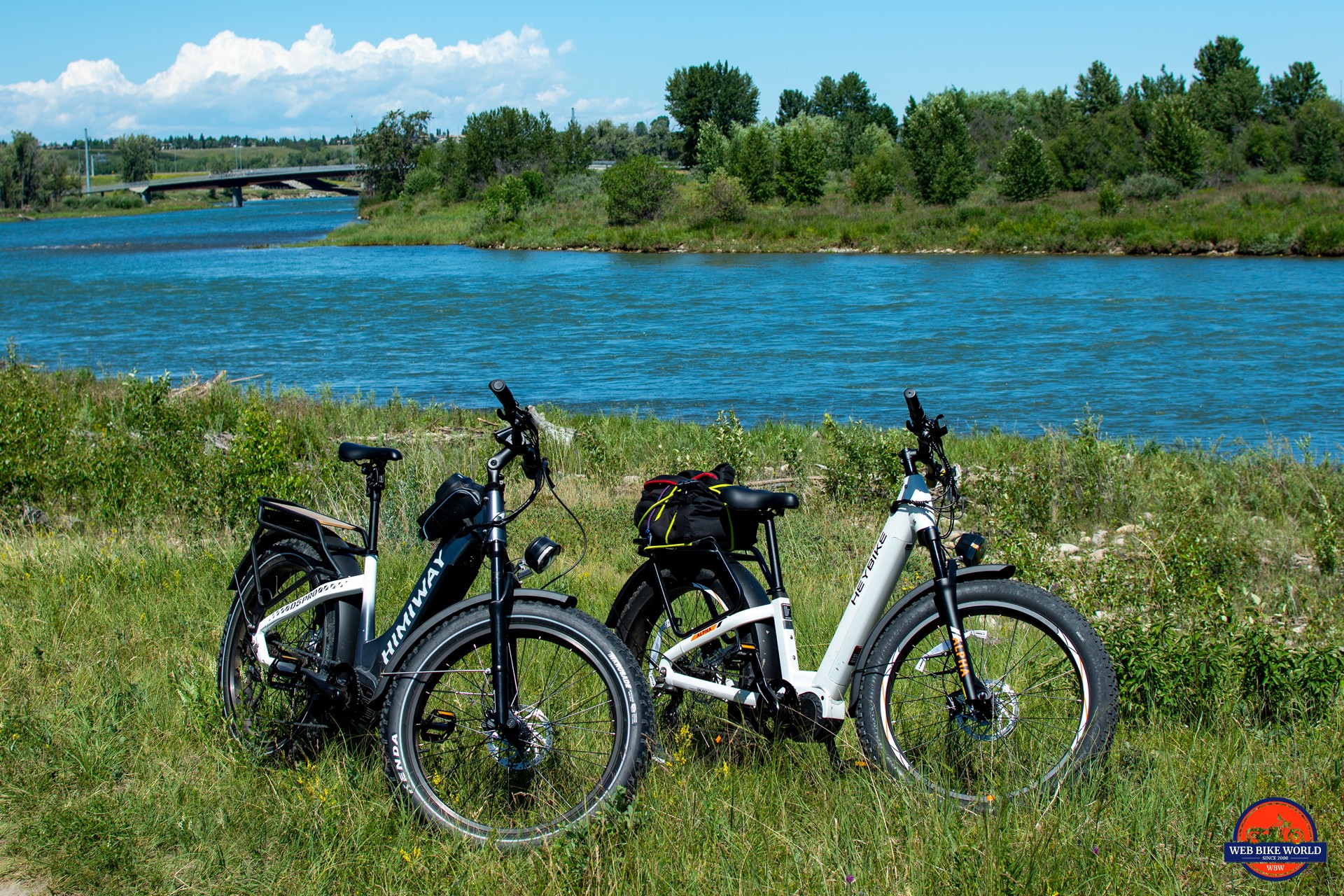
Competitors
There aren’t many fat tire/mid-drive combinations available at the $1,500 price point, and many bikes in this price range are hub drives with cadence sensors. To get a torque-sensing mid-drive with a respectable battery and hydraulic brakes at $1,500 is uncommon.
One of the Alpha’s closest competitors is also one I happen to have in my garage: the Himiway D5 Pro.
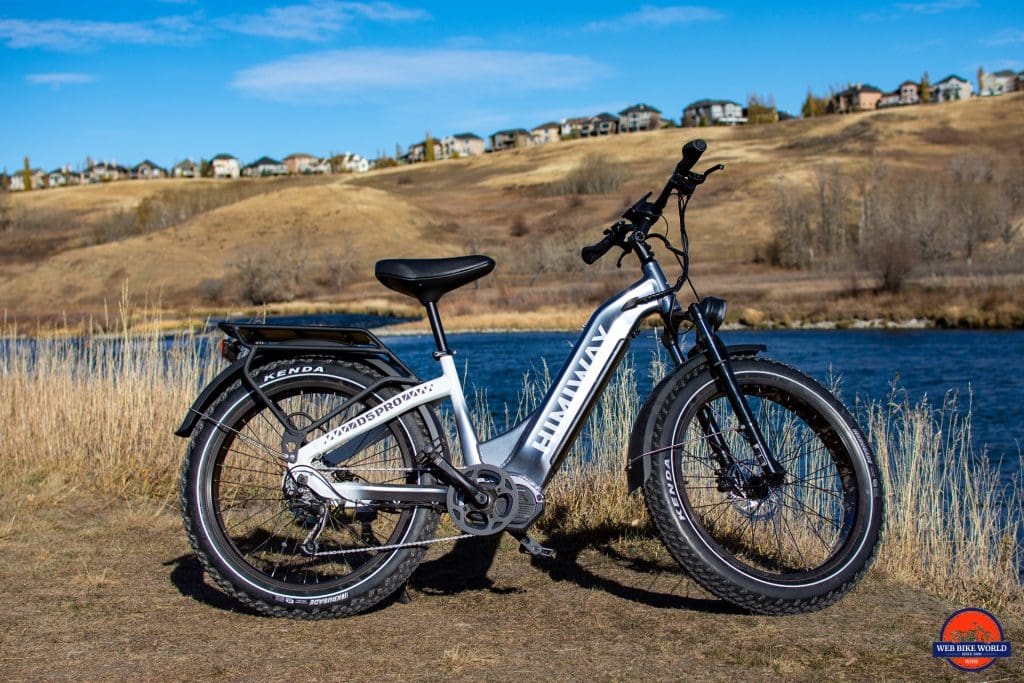
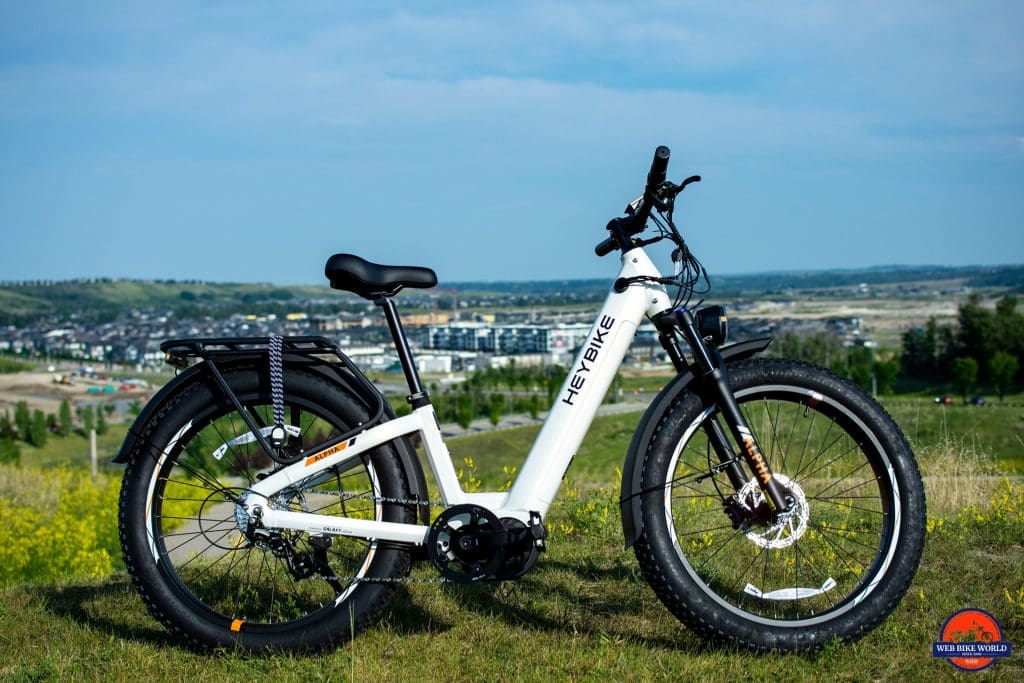
Fair warning: The D5 Pro comes in at least $700 more expensive at any given time. It’s also equally as competent, packed with a beefy torque-sensing mid-drive, Tektro hydraulic brakes, an adjustable stem, and sporting a better (though still not awesome) suspension fork… along with objectively the worst seat I’ve ever ridden with (toss it immediately and put on a proper saddle).
If you have the extra $700 to spend, the fact that the throttle on the D5 Pro functions like you want it to is enough of a reason to opt for the Himiway over the Heybike. However, if you really don’t want to spend that money, or it’s doable but a big stretch, the Alpha is a fine choice for the money (and also the better-looking of the pair).
Conclusion: The Heybike Alpha is a Fine Bike That Could be a Great One With a Few Small Changes
If you’ve made it this far, I think you’ll agree that this review is mixed even though the Alpha is so close to being so good.
The easiest fix for Heybike is to adjust the throttle so it performs like traditional ebike throttles, and in so doing the Alpha’s riding dynamics improve from a 3.5 to a 4.25. If there’s some budget to spare, skip the suspension fork and give me a better cassette. The fat tires can provide plenty of comfort, and the weight savings would be welcome.
Heybike, if you’re reading, please fix the throttle and trust that your customers can make decisions in their best interest regarding its use.
The thing is, if you aren’t inclined to use the throttle much and if you’re not too concerned about bouncy suspension for your casual rides, there is a lot to like about the Heybike Alpha. The potent motor is borderline addictive, and Heybike ships you everything you need to daily ride the Alpha right in the box.
If you want an affordable and competent four-season all-terrain bike, the Alpha is a worthy contender.
